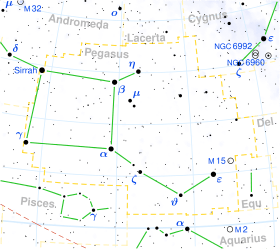Beta Pegasi
| Observation data Epoch J2000 Equinox J2000 | |
|---|---|
| Constellation | Pegasus |
| Right ascension | 23h 03m 46.45746s[1] |
| Declination | +28° 04′ 58.0336″[1] |
| Apparent magnitude (V) | 2.42[2] (2.31 - 2.74[3] |
| Characteristics | |
| Spectral type | M2.5II–IIIe[4] |
| U−B color index | +1.96[2] |
| B−V color index | +1.67[2] |
| Variable type | Semi-regular[5] |
| Astrometry | |
| Radial velocity (Rv) | +8.7[6] km/s |
| Proper motion (μ) | RA: +187.65[1] mas/yr Dec.: +136.93[1] mas/yr |
| Parallax (π) | 16.64 ± 0.15[1] mas |
| Distance | 196 ± 2 ly (60.1 ± 0.5 pc) |
| Absolute magnitude (MV) | -1.49 |
| Details | |
| Mass | 2.1[7] M☉ |
| Radius | 95[8] R☉ |
| Surface gravity (log g) | 1.20[9] cgs |
| Temperature | 3,689[9] K |
| Metallicity [Fe/H] | –0.11[9] dex |
| Rotational velocity (v sin i) | 9.7[10] km/s |
| Other designations | |
| Database references | |
| SIMBAD | data |
Beta Pegasi (β Pegasi, abbreviated Beta Peg, β Peg), also named Scheat,[11] is a red giant star and the second brightest star (after Epsilon Pegasi) in the constellation of Pegasus. It forms the upper right corner of the Great Square of Pegasus,[12] a prominent rectangular asterism.
Nomenclature
β Pegasi (Latinised to Beta Pegasi) is the star's Bayer designation.
It bore the traditional name of Scheat, a name that had also been used for Delta Aquarii. The name was derived from the Arabic Al Sā'id "the upper arm", or from Sa'd.[12] In 2016, the International Astronomical Union organized a Working Group on Star Names (WGSN)[13] to catalog and standardize proper names for stars. The WGSN's first bulletin of July 2016[14] included a table of the first two batches of names approved by the WGSN; which included Scheat for this star (the name Skat was later approved for Delta Aquarii[11]).
Arabian astronomers named it Mankib al Faras, meaning the "Horse's shoulder".
Distance and properties
Based upon parallax measurements, Beta Pegasi is located about 196 light-years (60 parsecs) from the Sun.[1] It is unusual among bright stars in having a relatively cool surface temperature compared to stars like the Sun.[8] This star has a stellar classification of M2.3 II–III,[4] which indicates the spectrum has characteristics partway between a bright giant and a giant star. It has expanded until it is some 95 times as large, and has a total luminosity of 1500 times that of the Sun.[8] The effective temperature of the star's outer envelope is about 3,700 K,[9] giving the star the characteristic orange-red hue of an M-type star.[15] The photosphere is sufficiently cool for molecules of titanium oxide to form.[16]
Beta Pegasi is a semi-regular variable with a period of 43.3 days[5] and a brightness that varies from magnitude +2.31 to +2.74 (averaging 2.42).[3] It is losing mass at a rate at or below 10−8 times the Sun's mass per year, which is creating an expanding shell of gas and dust with a radius of about 3,500 times the Sun's radius (16 Astronomical Units).[17]
References
- 1 2 3 4 5 6 van Leeuwen, F. (November 2007), "Validation of the new Hipparcos reduction", Astronomy and Astrophysics, 474 (2): 653–664, arXiv:0708.1752
 , Bibcode:2007A&A...474..653V, doi:10.1051/0004-6361:20078357
, Bibcode:2007A&A...474..653V, doi:10.1051/0004-6361:20078357 - 1 2 3 Johnson, H. L.; et al. (1966). "UBVRIJKL photometry of the bright stars". Communications of the Lunar and Planetary Laboratory. 4 (99): 99. Bibcode:1966CoLPL...4...99J.
- 1 2 "Query= bet Peg", General Catalogue of Variable Stars, Centre de Données astronomiques de Strasbourg, retrieved 2010-01-05
- 1 2 3 "V* bet Peg -- Pulsating variable Star", SIMBAD, Centre de Données astronomiques de Strasbourg, retrieved 2010-01-05
- 1 2 Tabur, V.; et al. (December 2009), "Long-term photometry and periods for 261 nearby pulsating M giants", Monthly Notices of the Royal Astronomical Society, 400 (4): 1945–1961, arXiv:0908.3228
 , Bibcode:2009MNRAS.400.1945T, doi:10.1111/j.1365-2966.2009.15588.x
, Bibcode:2009MNRAS.400.1945T, doi:10.1111/j.1365-2966.2009.15588.x - ↑ Wilson, Ralph Elmer (1953), "General Catalogue of Stellar Radial Velocities", Washington, Washington: Carnegie Institution of Washington, Bibcode:1953GCRV..C......0W
- ↑ Tsuji, Takashi (May 2007). "Isotopic abundances of Carbon and Oxygen in Oxygen-rich giant stars". In Kupka, F.; Roxburgh, I.; Chan, K. Convection in Astrophysics, Proceedings of IAU Symposium #239 held 21-25 August, 2006 in Prague, Czech Republic. Proceedings of the International Astronomical Union. 2. pp. 307–310. arXiv:astro-ph/0610180
 . Bibcode:2007IAUS..239..307T. doi:10.1017/S1743921307000622.
. Bibcode:2007IAUS..239..307T. doi:10.1017/S1743921307000622. - 1 2 3 Kaler, James B. (May 22, 2009), "SCHEAT (Beta Pegasi)", Stars, University of Illinois, retrieved 2010-01-05
- 1 2 3 4 Soubiran, C.; et al. (2008), "Vertical distribution of Galactic disk stars. IV. AMR and AVR from clump giants", Astronomy and Astrophysics, 480 (1): 91–101, arXiv:0712.1370
 , Bibcode:2008A&A...480...91S, doi:10.1051/0004-6361:20078788
, Bibcode:2008A&A...480...91S, doi:10.1051/0004-6361:20078788 - ↑ Massarotti, Alessandro; et al. (January 2008), "Rotational and Radial Velocities for a Sample of 761 HIPPARCOS Giants and the Role of Binarity", The Astronomical Journal, 135 (1): 209–231, Bibcode:2008AJ....135..209M, doi:10.1088/0004-6256/135/1/209
- 1 2 "IAU Catalog of Star Names". Retrieved 28 July 2016.
- 1 2 Allen, Richard Hinckley (1899), Star Names: Their Lore and Meaning, New York, NY: Dover Publications Inc., p. 325, ISBN 0-486-21079-0
- ↑ "IAU Working Group on Star Names (WGSN)". Retrieved 22 May 2016.
- ↑ "Bulletin of the IAU Working Group on Star Names, No. 1" (PDF). Retrieved 28 July 2016.
- ↑ "The Colour of Stars", Australia Telescope, Outreach and Education, Commonwealth Scientific and Industrial Research Organisation, December 21, 2004, archived from the original on 2012-03-10, retrieved 2012-01-16
- ↑ Gavin, M. (February 1996), "Stellar spectroscopy with CCDs - some preliminary results", Journal of the British Astronomical Association, 106 (1): 11–15, Bibcode:1996JBAA..106...11G
- ↑ Mauron, N.; Caux, E. (November 1992), "K I/Na I scattering observations in circumstellar envelopes - Alpha(1) Herculis, Omicron Ceti, TX PISCIUM and Beta Pegasi", Astronomy and Astrophysics, 265 (2): 711–725, Bibcode:1992A&A...265..711M. Solar Radius = 0.0046491 AU.
Coordinates: ![]() 23h 03m 46.458s, +28° 04′ 58.04″
23h 03m 46.458s, +28° 04′ 58.04″
